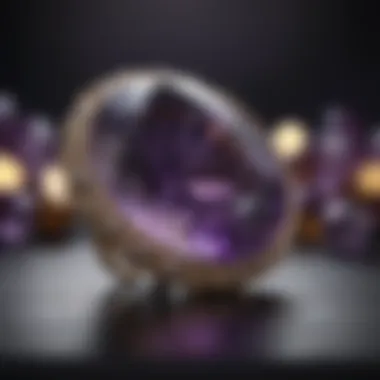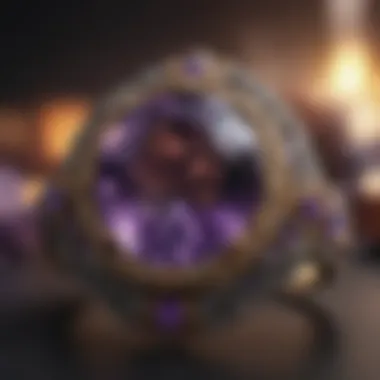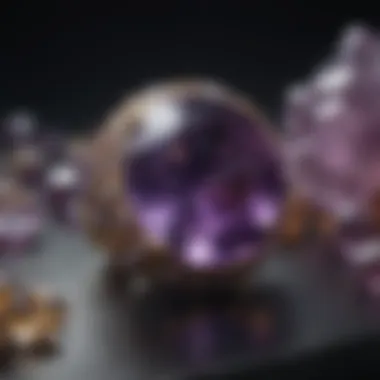Unveiling the Enchanting Birthstone Colors for February


Overview of Gemstones and Minerals
History of Gemstone and Mineral Use
The history of gemstones and minerals intertwines with human civilization, tracing back to ancient times when these precious stones were revered for their perceived mystical qualities. From adornment in royal jewelry to amulets for protection, gemstones have played diverse roles in different cultures and belief systems. Understanding the historical context of gemstone use provides a rich tapestry of knowledge that enhances our appreciation for these natural treasures.
Significance in Culture and Society
Gemstones carry symbolic meanings that transcend their physical beauty. In various societies, specific gemstones are associated with unique virtues, celestial alignments, and healing properties. These cultural significances have woven a intricate web of beliefs and rituals around gemstones, shaping their role in spiritual practices, ceremonies, and even medicinal applications. Exploring the cultural significance of gemstones reveals the deep connection between humans and the earth's geological wonders.
Gemstone Formation and Properties
The formation process of gemstones is a complex and fascinating journey that unfolds over millions of years. From the intense heat and pressure deep within the earth's mantle to the intricate crystallization processes, each gemstone undergoes a unique transformation before reaching the surface. These formation processes dictate the stunning colors, clarity, and durability that define precious stones.
Properties that Define Gemstones
Gemstones are distinguished by a variety of properties, including color, hardness, and luster. The vibrant hues of gemstones are a result of elemental impurities or defects in their crystal structures, giving each stone its distinctive appearance. Hardness, measured on the Mohs scale, determines a gemstone's resistance to scratches and abrasions, while luster describes the quality and intensity of light reflection from its surface.
Classification based on Color, Hardness, and Luster
Gemstones are classified based on a combination of factors, with color being one of the most prominent criteria. From the fiery red of rubies to the serene blue of sapphires, each gemstone hue evokes different emotions and associations. Hardness, which ranges from delicate to durable, categorizes gemstones into those suitable for everyday wear and those requiring special care. Meanwhile, luster distinguishes between the mesmerizing sheen of pearls and the brilliant sparkle of diamonds.
Types of Gemstones
Diving into the world of gemstones reveals a vast array of precious and semi-precious varieties, each with its own distinct allure and rarity. Understanding the differences between these gemstone types provides insight into their market value, historical significance, and symbolic meanings across cultures.
Precious vs. Semi-Precious Gemstones
The distinction between precious and semi-precious gemstones is based on traditional classifications that emphasize rarity, beauty, and durability. Precious gemstones, such as diamonds, emeralds, rubies, and sapphires, are highly sought after for their exceptional qualities and historical prestige. On the other hand, semi-precious gemstones encompass a broader range of stones like amethyst, aquamarine, and tourmaline, possessing unique colors and characteristics that make them prized in jewelry making.
Common Gemstone Varieties
Within the realm of gemstones, there exists a myriad of common varieties that have captured the imagination of gem enthusiasts worldwide. From the deep green hues of emeralds to the enchanting play of colors in opals, common gemstone varieties offer a diverse palette for jewelry design and personal adornment. Exploring these popular gemstones unveils a wealth of possibilities for creating stunning jewelry pieces that resonate with individual styles and preferences.
Exotic and Rare Gemstones
Beyond the familiar gemstone varieties lie exotic and rare treasures that hold a particular charm for collectors and connoisseurs. These gems, like alexandrite, jadeite, and tanzanite, are prized for their scarcity, unique coloration, and exceptional brilliance. Unearthing the beauty of exotic and rare gemstones opens up a realm of exploration and appreciation for the extraordinary wonders of the earth's gemological diversity.


Identifying and Evaluating Gemstones
The value of a gemstone is determined by a myriad of factors that encompass its quality, rarity, and market demand. Understanding how to identify and evaluate gemstones involves delving into the nuances of gemology, from assessing clarity and color to detecting treatments and enhancements that may affect a stone's value.
Factors Affecting Gemstone Value
Numerous factors influence the value of a gemstone, including its color saturation, clarity, cut quality, and carat weight. These aspects contribute to the overall beauty and desirability of a gemstone, with certain characteristics commanding higher prices due to their rarity or exceptional features. By evaluating these factors, gem enthusiasts can make informed decisions when acquiring or investing in precious stones.
Techniques for Gemstone Identification
Gemstone identification requires specialized knowledge and tools to distinguish between natural gemstones, synthetics, and imitations. Through techniques such as magnification, spectroscopy, and gemological testing, experts can accurately identify the authenticity and characteristics of a gemstone, ensuring its value and provenance are genuine.
Assessing Gemstone Quality
The quality of a gemstone is determined by its color consistency, transparency, and internal characteristics known as inclusions. Gemstone quality assessments involve grading these attributes on standardized scales to provide clarity on a gemstone's overall worth and suitability for various jewelry settings. By understanding how to assess gemstone quality, collectors and jewelers can select stones that meet their aesthetic and investment criteria.
Caring for Gemstones
Proper care and maintenance are essential for preserving the beauty and durability of gemstones, ensuring they retain their luster and brilliance over time. Implementing best practices in cleaning, storing, and handling gemstones safeguards their longevity and minimizes the risk of damage or wear due to environmental factors or mishandling.
Cleaning and Storing Gemstones Properly
Gemstones require gentle cleaning using mild soap and water to remove dirt and oils without causing damage. Storing gemstone jewelry in separate pouches or compartments prevents scratching and tangling, while avoiding exposure to harsh chemicals or extreme temperatures preserves their vibrancy and clarity.
Avoiding Common Mistakes in Gemstone Care
Common mistakes in gemstone care include using abrasive cleaners, exposing gems to direct sunlight, or wearing jewelry during strenuous activities that may damage delicate stones. By steering clear of these pitfalls and following recommended maintenance practices, gemstone enthusiasts can extend the lifespan and allure of their cherished pieces.
Preservation Tips for Specific Gem Types
Certain gem types, such as opals and pearls, require additional care due to their sensitivity to moisture and temperature fluctuations. Preserving these gems involves avoiding prolonged exposure to light, storing them in controlled environments, and periodically checking for any signs of damage or degradation. Tailoring preservation methods to specific gem types ensures their longevity and beauty for generations to come.
Introduction
The realm of gemstones and birthstone colors holds a mesmerizing allure, especially when delving into the captivating world of February birthstones. This section aims to unravel the mysteries and significance behind these gemstones that symbolize the unique characteristics and meanings associated with the month of February. Embracing the exploration of birthstones highlights the cultural, spiritual, and healing attributes that have intrigued scholars and enthusiasts for centuries. Let us embark on a journey through the essence of February's birthstone colors, discovering the hidden depths of these precious gems.
Brief Overview
Why Birthstones Hold Significance


Birthstones have long been revered for their mystical properties and deep-rooted connections to various aspects of life. The intricate link between birthstones and individuals has fascinated cultures across the globe, attributing specific virtues and powers to each gem. Understanding why birthstones hold significance entails unveiling the spiritual and symbolic meanings attached to these precious stones. The narrative behind birthstones goes beyond mere ornamentation, delving into the realms of folklore, astrology, and personal identity. Exploring the multifaceted significance of birthstones allows us to appreciate their enduring appeal and timeless relevance in the realm of jewelry and spiritual practices.
The Evolution of Birthstone Tradition
The evolution of the birthstone tradition traces back through centuries of human history, intertwining with diverse cultural beliefs and practices. Ancient civilizations imbued gemstones with symbolic importance, associating them with celestial powers and mystical qualities. As societies evolved, so did the interpretation of birthstones, with each era adding layers of meaning to these precious gems. The tradition of birthstones has evolved from ancient talismans to modern-day symbols of personal identity and style. Understanding the evolution of the birthstone tradition offers a glimpse into the collective consciousness of humanity and our enduring fascination with the beauty and symbolism of gemstones.
February Birthstones
The Importance of Birthstones for February
February birthstones hold a special significance, embodying the essence of the month and resonating with individuals born during this time. The importance of February birthstones lies in their unique characteristics and properties, reflecting the spiritual and emotional dynamics of the month. Exploring the significance of these gemstones unveils a tapestry of meanings and symbolisms that enrich the personal connections individuals have with their birthstones. Each February birthstone carries a distinctive aura, offering insights into the wearer's personality and journey through life. Embracing the beauty and significance of February birthstones enhances our appreciation for the wonders of nature and the enduring legacy of these precious gems.
Amethyst: The Regal February Birthstone
Amethyst is a gemstone of regal importance and significance within the realm of February birthstones. Revered for its mystical allure and captivating beauty, Amethyst holds a prominent place in the world of gemology. Its rich history intertwined with various mythical narratives and royal affiliations makes it a focal point of intrigue for gemstone enthusiasts.
History and Lore
Mythological Connections
Exploring the mythological connections surrounding Amethyst reveals a tapestry of symbolism and legends. Intricately linked to ancient beliefs and folklore, Amethyst is often associated with attributes like wisdom, clarity, and spiritual protection. The mythical tales woven around Amethyst bring forth its overarching symbolism as a gem of balance and insight. Despite being shrouded in mystery, the mythical connections of Amethyst elevate its status to a gemstone of transcendental beauty and esoteric significance.
Royal Affiliations
Delving into the royal affiliations of Amethyst uncovers a lineage of noble admiration and prestige. From adorning the crowns and jewelry of monarchs to symbolizing power and authority, Amethyst has maintained its regal stature throughout history. The deep purple hues of Amethyst were once exclusively reserved for royalty, symbolizing luxury and mystique. The royal affiliations of Amethyst not only showcase its aesthetic appeal but also underscore its timeless association with nobility and grandeur.
Characteristics
Color Variations
The color variations of Amethyst range from pale lavender to deep purple, each hue exuding its distinctive charm and elegance. The mesmerizing gradients of color within Amethyst gemstones showcase natural variations in hue and saturation, adding depth and dimension to its allure. The diversity of color variations in Amethyst caters to a wide spectrum of preferences, making it a versatile choice for jewelry designers and collectors seeking unique pieces that reflect individuality and style.
Properties and Meanings
The properties and meanings attributed to Amethyst delve into its metaphysical and healing qualities. Known for its calming presence and ability to instill a sense of peace, Amethyst is revered for its stress-relieving properties and spiritual significance. From promoting creativity to enhancing intuition, Amethyst embodies a myriad of meanings that resonate with individuals seeking emotional balance and spiritual alignment. The inherent properties of Amethyst make it a gemstone cherished not only for its aesthetic appeal but also for its therapeutic benefits.
Significance


Spiritual and Healing Attributes
Amethyst is celebrated for its spiritual and healing attributes, believed to cleanse negative energies and promote spiritual growth. The crystal-clear vibrations of Amethyst are thought to stimulate the mind and enhance psychic abilities, making it a favored gemstone for spiritual practitioners and meditation enthusiasts. The spiritual and healing attributes of Amethyst encompass a wide range of benefits, from alleviating anxiety to fostering spiritual enlightenment, solidifying its position as a gem of profound significance and holistic well-being.
Cultural Symbolism
In various cultures around the world, Amethyst carries symbolic meanings tied to spirituality, protection, and abundance. From ancient civilizations to modern societies, Amethyst has been revered for its purifying properties and talismanic significance. Its cultural symbolism extends to themes of intuition, transformation, and divine connection, making Amethyst a gemstone of cultural reverie and symbolic depth. The enduring cultural symbolism of Amethyst further enhances its allure and timeless appeal in the realm of gemstone lore.
The Enigmatic Beauty of Kunzite
Kunzite, a mesmerizing gemstone prominent for its alluring hues and mysterious aura, plays a crucial role in unraveling the captivating world of birthstone colors for February. As we delve into the enigmatic beauty of Kunzite, we are met with a gemstone that exudes elegance and charm, attracting gemstone enthusiasts, collectors, and jewelry designers alike with its distinctive allure. Its significance in this article lies in its unique properties, emotional healing qualities, and the rich symbolism associated with it, making it a standout among the array of February birthstones. Kunzite's presence in the realm of gemstones adds a layer of depth and sophistication, captivating those who appreciate the subtleties and beauty of rare gems.
Origins and Discovery
Unveiling the Mysteries
Unveiling the Mysteries of Kunzite reveals intriguing facets of its origin story and discovery, shedding light on the factors that contribute to its enigmatic appeal. This section explores the specific aspects of Kunzite's emergence, highlighting the journey of this gemstone from its geological formations to its unearthing by experts and enthusiasts. Delving deeper into the mysteries surrounding Kunzite unveils a narrative of exploration and admiration, elevating its status in the world of gemstones.
Distinctive Features
The distinctiveness of Kunzite's features adds a layer of complexity to its allure, making it a popular choice for those seeking a gemstone with unique characteristics. By focusing on the key attributes that set Kunzite apart from other gemstones, we gain insight into its exceptional qualities and visual appeal. Exploring the distinctive features of Kunzite provides a comprehensive understanding of why it continues to be a sought-after gemstone in the realm of jewelry design and collection, offering both advantages in aesthetics and symbolism.
Qualities and Symbolism
Emotional Healing Properties
Kunzite's emotional healing properties serve as a cornerstone of its significance, offering individuals a sense of calm, rejuvenation, and balance. This section delves into the specific aspects of Kunzite that contribute to its reputation as a gemstone with healing qualities, exploring how it soothes the mind and spirit. By discussing the emotional healing properties of Kunzite, we unravel its holistic benefits and the role it plays in promoting well-being and emotional harmony.
Associated Beliefs
The associated beliefs tied to Kunzite add a layer of cultural and metaphysical significance to this gemstone, making it a compelling choice for those interested in its symbolic meanings. This segment delves into the rich folklore and traditions surrounding Kunzite, highlighting the beliefs and interpretations that have been passed down through generations. By exploring the associated beliefs of Kunzite, we gain a deeper appreciation for the cultural and spiritual value this gemstone holds, enriching our understanding of its role in the realm of birthstone colors for February.
Conclusion
In delving deep into the world of birthstone colors for February, it becomes evident that the exploration of these gemstones carries substantial significance and intrigue. This concluding section serves as the culmination of our journey, offering a comprehensive overview of the gemstones that symbolize February. By examining the lore, meanings, and beauty associated with these stones, we unravel a tapestry of mysteries and allure that have captivated humanity throughout history. Furthermore, by exploring the unique characteristics and significance of February's birthstone colors, we gain a deeper understanding of not just the gemstones themselves, but also the cultural and personal connections they foster. The importance of this topic lies in the timeless appeal and symbolism that birthstones hold, enriching our lives with their beauty and meaning.
Appreciating February's Birthstone Colors
The Timeless Allure
Embarking on a journey to appreciate February's birthstone colors unveils a mesmerizing world of allure and fascination. The Timeless Allure of these gemstones lies in their ability to transcend time and trends, offering a timeless elegance that appeals to individuals across generations. Their enduring beauty and significance make them a sought-after choice for jewelry and personal adornment, symbolizing a connection to both the past and the present. The key characteristic of The Timeless Allure is its ability to evoke a sense of tradition while remaining relevant in contemporary contexts, making it a versatile and enduring option for gemstone enthusiasts and collectors. This uniqueness ensures that The Timeless Allure continues to be a popular and cherished aspect of February's birthstone colors, accentuating their timeless appeal.
Personal Connection
Delving deeper into the realm of February's birthstone colors reveals the importance of forging a Personal Connection with these precious gemstones. The Personal Connection aspect delves into the emotional and symbolic meanings attached to these stones, highlighting their role in personal narratives and expressions. By recognizing the key characteristic of Personal Connection, we understand that these gemstones hold a special place in the hearts of individuals, signifying love, strength, and spirit. Their unique feature lies in their ability to resonate with personal stories and experiences, creating a bond between the wearer and the gemstone that transcends mere aesthetics. While the advantages of this personal bond include emotional fulfillment and meaningful symbolism, it is essential to acknowledge the individualistic nature of such connections, as each interaction with these gemstones is deeply personal and subjective.







